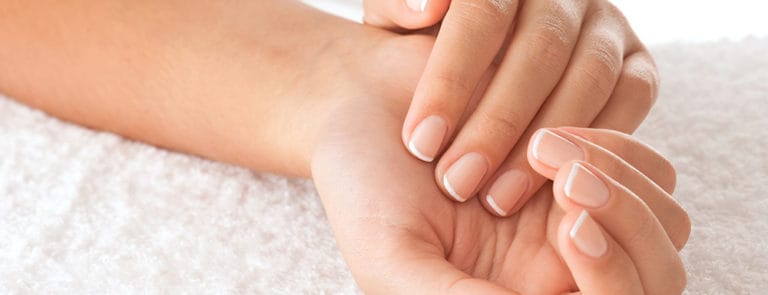15% off £35 OR 20% off £45
Code:FAVES
Top tips to tackle brittle nails

Do you find your nails breaking or chipping easily? There are ways to keep your nails healthy and reduce how brittle they are. Find out how to tackle brittle nails here.
Are your nails prone to chipping and breaking? Discover the best ways to nurse them back to health
Did grandmother always tell you to put on the Marigolds before doing the dishes? She may have had a point about protecting your nails.
Find out how to look after your nails, with these simple steps.
What causes brittle nails?
Around one in five people have brittle nails, and it affects more women than men.1 Nails are made from layers of the protein keratin, placed on top of one another like roof tiles. If air gets into the spaces between them, for example from cold winds, they swell, causing the nail to break, chip or split.2,3 In the same way, regularly immersing your fingers in water swells the gaps between the keratin. When the water then leaves, it triggers dry, brittle nails.4 It’s very common for nails to break more easily as we age too. Our nails can also change during pregnancy, becoming softer, harder or more brittle.5,6Handpicked content: Find out what your nails could be saying about your health
Handpicked content: 3 pregnancy basics you need to know
The golden rule: gloves and moisturiser
Handling chemicals? Or do you spend a lot of time with wet hands, or your fingers immersed in water? You need to protect your healthy nails with rubber or latex gloves.7 Slather your hands and nails in moisturiser every day too. Look for a hand cream that contains a humectant to draw in moisture, for example glycerine or honey, plus an emollient, such as shea butter, olive oil or coconut oil, to seal in water.8,9Avoid acetone nail polish remover
Acetone – found in certain nail polish removers – has a drying effect on nails. Make sure you buy acetone-free versions, or ask your beautician to use acetone-free remover when you have a manicure.10 You could have a break, and go for natural nails, for a short while too.See your GP
Sometimes brittle nails are a symptom of an underlying condition, like hypothyroidism or Raynaud’s syndrome. See your GP to rule these out.11,12 Ask for a blood test too, as zinc deficiency and iron-deficiency anaemia can both cause nail problems. Zinc is needed for cell growth, while iron-deficiency anaemia can trigger a brittle nail condition called koilonychia.13,14,15Handpicked content: Why you should start taking zinc – today
Bump up your biotin
Researchers think that taking biotin, or vitamin B7, could also be a useful way to tackle brittle nails. A Swiss study published in the journal Cutis in 1993 gave 35 patients with brittle nails a daily supplement of biotin. After six months, 63% saw an improvement in nail thickness.16 A 2017 review from the Journal of Dermatological Treatment, concluded that taking biotin could make your fingernails harder and thicker.17Avoid alcohol-based hand-sanitiser
An investigation carried out in two Leeds teaching hospitals in 2011 found that the alcohol in alcohol-based hand sanitiser gels was an irritant in 88% of participants, causing flaking, brittle nails.18 If you can, wash your hands using a tea tree oil soap instead as it has natural antiseptic and antibacterial properties.19
1. Abdullah L. Common nail changes and disorders in older people. Available from: https://www.ncbi.nlm.nih.gov/pmc/articles/PMC3038811/
2. New York Times. New Ways to moisturize those brittle nails. Available from: https://www.nytimes.com/2006/04/06/fashion/thursdaystyles/new-ways-to-moisturize-those-brittle-nails.html
3. American Osteopathic College of Dermatology. Brittle splitting nails. Available from: http://www.aocd.org/?page=BrittleSplittingNail
4. As Source 2
5. As Source 1
6. NHS Choices. Nail problems. Available from: https://www.nhs.uk/conditions/nail-problems/#indented-spoon-shaped-nails-koilonychia
7. As Source 3
8. As Source 2
9. Sethi A, et al. Moisturizers: The Slippery Road. Available from: https://www.ncbi.nlm.nih.gov/pmc/articles/PMC4885180/
10. As Source 3
11. MedicineNet.com. Brittle Nails: Symptoms and Signs. Available from: https://www.medicinenet.com/brittle_nails/symptoms.htm
12. Solomons HD. Raynaud’s phenomenon. Available from: https://www.ncbi.nlm.nih.gov/pmc/articles/PMC3721961/
13. Ambooken B, Binitha MP, Sarita S. Zinc Deficiency Associated with Hypothyroidism: An Overlooked Cause of Severe Alopecia. Available from: https://www.ncbi.nlm.nih.gov/pmc/articles/PMC3746228/
14. Moiz B. Spoon nails: still seen in today’s world. Available from: https://www.ncbi.nlm.nih.gov/m/pubmed/29531740/
15. NHS Choices. Vitamins and minerals: zinc. Available from: https://www.nhs.uk/conditions/vitamins-and-minerals/others/
16. Hochman LG, Scher RK, Meyerson MS. Brittle nails: response to daily biotin supplementation. Available from: https://www.ncbi.nlm.nih.gov/pubmed/8477615
17. Lipner SR, Scher RK. Biotin for the treatment of nail disease: what is the evidence? Available from: https://www.ncbi.nlm.nih.gov/pubmed/29057689
18. McKenzie SN, et al. Alcohol hand abuse: a cross-sectional survey of skin complaints and usage patterns at a large UK teaching hospital. Available from: https://www.ncbi.nlm.nih.gov/pmc/articles/PMC3166264/
19. Mantil E, Daly G, Avis TJ. Effect of tea tree (Melaleuca alternifolia) oil as a natural antimicrobial agent in lipophilic formulations. Available from: https://www.ncbi.nlm.nih.gov/pubmed/25515896
Advice is for information only and should not replace medical care. Please check with your GP before trying any remedies.
Related Articles
Shop by wellness goal
Sign up for exclusive offers
Plus, get expert advice to support your health & wellness straight to your inbox when you sign up to Holland & Barrett emails.
Read our
privacy policy


.png)










